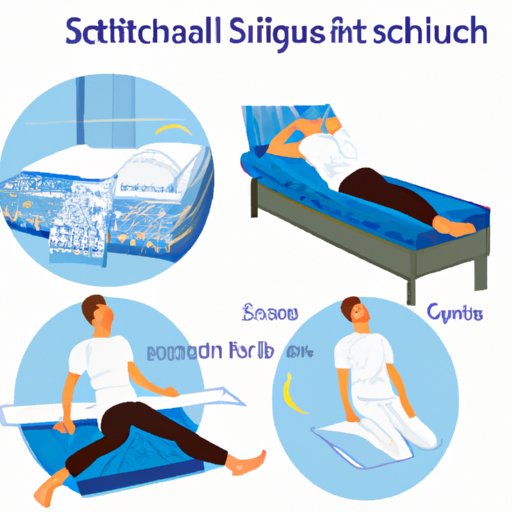
Introduction
Sciatica is a common condition that causes pain, numbness, and tingling sensations in the lower back, buttocks, and legs. While many people experience mild to moderate sciatic pain during the day, it can be especially problematic at night, making it difficult to fall asleep or stay asleep. This article aims to provide tips for managing sciatica pain while sleeping to help you achieve better sleep and overall health.
Section 1: Discuss Sleeping Positions
Your sleeping position can have a significant impact on the quality of your sleep and sciatic pain. Those with sciatica should avoid sleeping on their stomach as it puts pressure on the lower back and can worsen pain. Instead, try sleeping on your side with a pillow between your knees. This position keeps your spine aligned and helps reduce pressure on the sciatic nerve.
Additionally, it is essential to maintain proper posture throughout the night. Avoid twisting or bending your spine and keep your neck and back in a neutral position. Choose a firm or medium-firm pillow that keeps your neck and head aligned with the rest of your body. Finding the right sleeping position may take some experimentation, so be patient in finding the position that works best for you.
Section 2: Use Pillows and Sleep Aids
Pillows and other sleep aids can significantly help reduce sciatica pain, mostly when used correctly. Try placing a rolled-up towel under your waist while sleeping on your side or between your knees while lying on your back. A wedge pillow can help elevate your head, reducing pressure on your lower back. A cushion or a padded mattress topper can also help provide extra support and comfort.
When choosing a pillow or other sleep aid, make sure it is of high quality and suitable for treating sciatic pain. Don’t forget to consult your doctor or physical therapist before using any of these aids.
Section 3: Adjusting the Mattress
The type of mattress you sleep on may influence the severity of your sciatic pain. Traditional innerspring mattresses may not provide adequate spinal support, leading to unwanted pressure on the lower back. On the other hand, memory foam mattresses or medium-firm mattresses have been shown to help alleviate sciatic pain.
If you do not have the budget to buy a new mattress, consider adding a mattress pad or topper. A good mattress pad can provide extra cushioning and support while keeping your spine aligned. A mattress pad made with high-density foam or latex may be a good option for sufferers of sciatica.
Section 4: Light Exercising
Light stretches and gentle exercises before bed can help reduce sciatica pain, prepare your body for sleep while promoting relaxation. Sciatica stretches such as knee-to-chest stretch and hamstring stretch can help loosen up your muscles and reduce pressure on the lower back.
Remember to take it slow and steady when stretching, and never do anything that causes severe discomfort or pain. Gentle yoga and swimming may also offer additional benefits in reducing overall pain and stress levels.
Section 5: Guided Meditation
Stress can increase sciatic pain, resulting in poor sleep quality. Guided meditation techniques can help reduce stress, promote relaxation and help calm the body and mind before bedtime. Some of the most beneficial meditative techniques for sciatica are deep breathing, mental visualization, and yoga Nidra.
Guided meditation apps like Headspace and Calm offer meditative sessions of 5-15 minutes, making it an easily accessible and practical tool.
Section 6: Hot and Cold Therapy
Alternate use of hot and cold therapy can be a powerful tool to manage sciatica pain. Hot therapy can increase blood flow and circulation, relaxing muscles and providing relief from mild pain. Cold therapy, on the other hand, reduces inflammation, numbing the area, and easing sharp pain.
Try to apply a cold pack for 20 minutes and then a hot pack for 20 minutes, making sure to avoid applying a pack so long to cause damage to the skin. It may take some time to find the right balance for your pain so start cautiously and listen to your body.
Section 7: Pain Medication
If pain medication is needed, always consult with your doctor or physical therapist before taking any. Over-the-counter pain relievers such as ibuprofen and acetaminophen can offer short-term relief from sciatic pain. Prescription medications like anti-inflammatory drugs are available if pain persists.
However, keep in mind that using pain medication should be a last resort, it should be taken with caution and patients must be aware of any potential side effects.
Conclusion
Sleeping with sciatica can be a challenging task, but it is manageable. The right combination of techniques can help alleviate pain, reduce stress and promote relaxation, allowing for a better night’s sleep. Experiment with different tips and consult your doctor or physical therapist if you need further support. A good night’s sleep is crucial to overall health and wellbeing.





